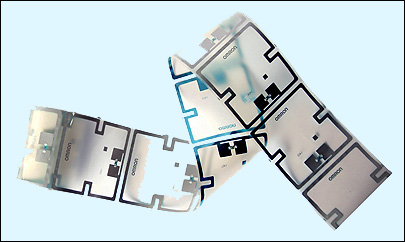Japanese electronics firm Omron has announced a new EPC Gen 2 UHF RFID inlay dubbed the Ninja, designed for item-level tagging of pharmaceutical products.
The Ninja inlay, which is 1.1 inches square (28 mm square), is designed to fit under most labels found on pharmaceutical bottles. It has a considerably shorter read range than larger Gen 2 tags used for tracking cases and pallets of goods in the retail supply chain.
The Ninja’s four-foot read range makes it suited for use in tracking individual items (tags made for case- and pallet-tracking generally have a range of 15 to 25 feet). When a large number of tagged items, such as a tightly-packed case of pharmaceutical bottles, is read at close proximity, the shorter read range can limit the number of unintentional tags—those placed on items outside the case—that the interrogator collects.
Users of RFID technology in the pharmaceutical industry have been divided over using ultra-high-frequency tags for item-level tracking, and those that transmit in the high-frequency (HF) range, with Pfizer and GlaxoSmithKline (GSK) are using HF tags for item-level tracking (see GlaxoSmithKline Tests RFID on HIV Drug and Pfizer Using RFID to Fight Fake Viagra) while drugmaker Purdue is using UHF (see Purdue Pharma Tags OxyContin).
The passive HF tag market is more mature than the UHF market, but each type of tag has advantages and disadvantages for item-level tracking. One advantage Gen 2 UHF tags have over HF standards is a higher data rate. Bill Arnold, chief strategist for Omron, says early tests show that more than 300 Ninja tags can be read per second.
Last month, Omron also introduced the UHF Loop inlay for case and pallet tracking. At 2.76 x 2.68 inches (70.0mm x 68.0mm), the Omron Loop inlay is a considerably larger inlay than the Ninja. Designed for use on items contain RF-unfriendly materials such as liquids and metals, it has a read range of 10 to 15 feet.
Arnold says the Loop, the Ninja and the Wave—the first in Omron’s line of UHF Gen 2 inlays (introduced in April)—are optimized to be read from the low end of the UHF band (around 860 MHz, which is used in Europe), through the middle of the band (around 915 Mhz, used in the United States) and up into the higher ends of the band (around Japan’s 960 MHz). Many Gen 2 tags from other vendors are optimized to work best in only one or two of these regions.
“Gen 2 is supposed to be a global standard, but if the tag can’t travel [can’t be read everywhere], how good is the global standard?” asks Arnold. He adds that the UHF Gen 2 inlays, which it sells to label converts who embed them in adhesive smart labels, were developed to be used in all parts of the world.
All three of Omron’s Gen 2 inlays also use an etched aluminum antenna. Aluminum costs less than copper, which is a more conductive material and is more widely used in passive tag antennas. Aluminum is environmentally friendlier than copper. Arnold says all three inlays are available now in production quantities, though the company has not yet released pricing information.


